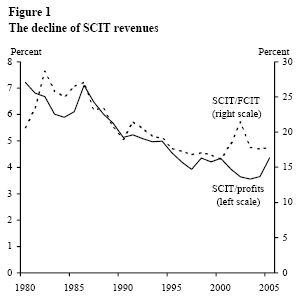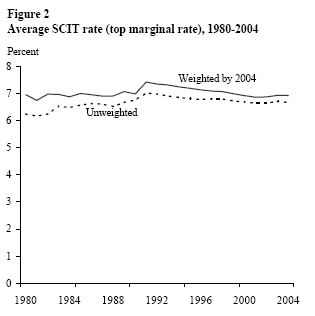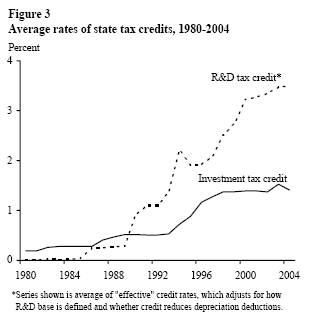The share of corporate profits in the U.S. collected by state governments via the corporate income tax has fallen sharply in the past quarter century. Some commentators have even referred to this as the “disappearance” of the state corporate income tax (SCIT).
- The primary factors determining SCIT
- How have the primary SCIT factors changed?
- Conclusion
- Reference
The share of corporate profits in the U.S. collected by state governments via the corporate income tax has fallen sharply in the past quarter century. Some commentators have even referred to this as the “disappearance” of the state corporate income tax (SCIT). Such claims, of course, are an exaggeration—after all, a longer perspective reveals that the share of profits collected by state corporate income taxes was actually lower in the 1960s than it is now. Nonetheless, state public finance experts and state policymakers surely are correct in noting that, since around 1980, corporate income taxes have become an increasingly smaller share of total state tax revenues and a smaller share of businesses’ costs.
This Economic Letter attempts to unravel the mystery of falling state corporate income taxes by analyzing the primary determinants of these taxes and reviewing how they have changed in the last 25 years.
The primary factors determining SCIT
Before discussing the possible causes of the decline in SCIT/profits, it is useful to go over how corporate business income is taxed by states. First, a corporation determines its federal taxable income; in general, states use this as the basis for their own corporate income tax. The corporation then allocates this income to any state in which it has a sufficient presence—or “nexus”—according to each state’s allocation formula. Once a business has allocated income to a state, it then subtracts any state-specific deductions (for example, federal tax payments are deductible in a small number of states) to arrive at state taxable income. Finally, the firm applies the legislated (or statutory) corporate income tax rate to its state taxable income and then reduces that amount by the value of any state-specific tax credits.
Thus, three factors influence a state’s corporate tax revenues as a share of profit (income)—its apportionment of federal taxable income, its legislated tax rate (adjusted for deductions), and its tax credits—and common trends in these factors among states will have similar effects on the aggregate share of profits captured by state taxes. In addition, this aggregate share will be affected by the share of corporate profits that is considered federally taxable and by the distribution of income across states.
How have the primary SCIT factors changed?
One area of change has been in the formulas dictating how businesses allocate federal taxable income to the states. Although each state has leeway in choosing its formula (subject to the strictures of Public Law 86-272, which bans states from taxing businesses with no physical presence in the state), traditionally, the formulas have required a business to allocate income to a state in proportion to its share of the business’s nationwide sum of sales, payroll, and property, where each of the three is equally weighted. However, over the past 30 years or so, most states have increased the weight on sales in this formula (some all the way to 100%) to encourage businesses to invest and create jobs in their states. As a result of different apportionment formulas, it is quite possible for more or less than 100% of a business’s income to be allocated among states. For example, a manufacturer located in state A that sells its product in state B could end up allocating much less than 100% of its federal taxable income to states A and B combined if state A’s formula were based only on sales. Some states have “throwback” rules to tax at least a portion of the income that escapes state taxation, but these are limited and far from universal.
The increasing non-uniformity across states in apportionment formulas over the past 30 years has afforded businesses increasing latitude to site operations so as to maximize the share of federal taxable income that escapes state taxation. It is likely that this increased non-uniformity has contributed to the declining share of profits captured by states. However, it also should be noted that the non-uniformity trend appears to have reversed itself somewhat in recent years, with the majority of states now weighting sales primarily or exclusively, so the contribution of this factor has probably waned.
 A closely related factor that many state tax experts have pointed to for the decline in SCIT is increased tax planning or avoidance by businesses. As Figure 1 shows, it appears that avoidance of federal corporate income tax (FCIT) is probably not a significant part of this explanation, as SCIT has fallen not just relative to total profits but also relative to FCIT over the last 25 years. Still, there are other possibilities to consider. For example, in recent years, a good deal of attention has focused on the use of so-called passive investment companies or PICs. Because a handful of “tax haven” states do not tax specific forms of income, such as trademark royalties or interest income on loans, large multistate businesses often set up subsidiaries in these states to which the rest of the company pays large royalty fees or interest on loans. This effectively shifts income out of other states and into the tax haven states, avoiding state taxation on the income. The use of PICs has become increasingly common since the mid-1980s. Intracompany income transfers are not publicly reported, so the extent to which this could explain the decline in SCIT’s share of profits is unknown, but it seems likely that it is of at least some significance.
A closely related factor that many state tax experts have pointed to for the decline in SCIT is increased tax planning or avoidance by businesses. As Figure 1 shows, it appears that avoidance of federal corporate income tax (FCIT) is probably not a significant part of this explanation, as SCIT has fallen not just relative to total profits but also relative to FCIT over the last 25 years. Still, there are other possibilities to consider. For example, in recent years, a good deal of attention has focused on the use of so-called passive investment companies or PICs. Because a handful of “tax haven” states do not tax specific forms of income, such as trademark royalties or interest income on loans, large multistate businesses often set up subsidiaries in these states to which the rest of the company pays large royalty fees or interest on loans. This effectively shifts income out of other states and into the tax haven states, avoiding state taxation on the income. The use of PICs has become increasingly common since the mid-1980s. Intracompany income transfers are not publicly reported, so the extent to which this could explain the decline in SCIT’s share of profits is unknown, but it seems likely that it is of at least some significance.
 A third factor that would lower the share of profits captured by state corporate taxes could be a trend toward lower state tax rates, especially if it occurred disproportionately among states with large shares of national income. In fact, however, corporate tax rates have been roughly constant, on average, since 1980. This is shown in Figure 2, which plots the average top marginal corporate income tax rate among states from 1980 to 2004. (These rates have been adjusted for the deductibility of federal taxes from state income for those few states that allow such deductibility). The figure provides both an unweighted average and an average weighting states by their 2004 gross state products (as a proxy for corporate income). While both measures have fallen since 1992, they are at or above where they were in 1980. Thus, the decline in state corporate taxes’ share of profits since 1980 cannot be attributed to changes in legislated tax rates.
A third factor that would lower the share of profits captured by state corporate taxes could be a trend toward lower state tax rates, especially if it occurred disproportionately among states with large shares of national income. In fact, however, corporate tax rates have been roughly constant, on average, since 1980. This is shown in Figure 2, which plots the average top marginal corporate income tax rate among states from 1980 to 2004. (These rates have been adjusted for the deductibility of federal taxes from state income for those few states that allow such deductibility). The figure provides both an unweighted average and an average weighting states by their 2004 gross state products (as a proxy for corporate income). While both measures have fallen since 1992, they are at or above where they were in 1980. Thus, the decline in state corporate taxes’ share of profits since 1980 cannot be attributed to changes in legislated tax rates.
Another possible factor behind the decline in state corporate taxes’ share of profits could be shifts in economic activity toward states with lower tax rates. Fisher (2002) analyzed this possibility in detail and found that states with higher legislated tax rates actually have experienced faster economic growth than other states, at least since the late 1980s. Moreover, there is a zero, or a slightly negative, correlation between legislated tax rates and the sales-weight in apportionment formulas, so it does not appear that high tax rates are offset by more favorable apportionment rules.
A final important determinant of state corporate taxes is credits. Many states offer businesses various tax credits to encourage particular activities. The two most common types are investment tax credits (ITCs) and research and development (R&D) tax credits (RDTCs). The value of a credit is determined by multiplying the credit rate by some measure of the targeted activity, such as capital expenditures. A trend toward higher credit rates, even if the level of targeted activity remains the same, would have a negative effect on state corporate tax revenues. To the extent that these credits have shifted economic activity, and, hence, corporate income, toward states offering these credits, the negative effect is even greater.
 Figure 3 shows that average credit rates for ITCs and RDTCs have indeed risen dramatically since 1980. The average ITC rate rose from 0.2% in 1980 to 1.4% by 2004, while the average RDTC rate rose from 0 to 3.5%. The increase in each of these average credit rates is due to a combination of an increase in the number of states with credits and an increase in the credit rates for those states with a credit. In 1980, just six states had an ITC and no state had an RDTC. By 2004, 20 states had an ITC and 31 had an RDTC.
Figure 3 shows that average credit rates for ITCs and RDTCs have indeed risen dramatically since 1980. The average ITC rate rose from 0.2% in 1980 to 1.4% by 2004, while the average RDTC rate rose from 0 to 3.5%. The increase in each of these average credit rates is due to a combination of an increase in the number of states with credits and an increase in the credit rates for those states with a credit. In 1980, just six states had an ITC and no state had an RDTC. By 2004, 20 states had an ITC and 31 had an RDTC.
A simple back-of-the-envelope calculation provides a rough sense of the extent to which these tax credits could explain the declining SCIT share of profits. Based on national data on business investment in equipment and structures and R&D, combined with the average credit rates, I compute that the amount of these credits (combined) grew by $22.4 billion between 1980 and 2004. If average credit rates had not changed, the credit amount instead would have grown by just $1.7 billion; hence, about $21 billion can be attributed to the change in credit rates. If this $21 billion were added to 2004 state tax revenues, I calculate that the SCIT share of profits would have fallen by about 25% rather than the 50% fall that actually occurred.
This Economic Letter has discussed a number of possible factors behind the steep drop in state corporate tax revenues as a share of profits since 1980. The average credit rate for the two most common types of credits has risen considerably since 1980, while there has been no decline in corporate tax rates and no apparent shift in economic activity toward states with lower tax rates. I find the increase in average credit rates could explain around half of the decline in SCIT’s share of profits. The increasing non-uniformity of taxation across states and the increasing exploitation of this non-uniformity also likely has played a role. Specifically, the non-uniformity in apportionment formulas and the use of passive investment companies likely have increased the share of federal taxable income that escapes state taxation altogether.
Daniel Wilson
Economist
Fisher, Peter. 2002. “Tax Incentives and the Disappearing State Corporate Income Tax.” State Tax Notes (March 4) pp. 767-774.
Opinions expressed in FRBSF Economic Letter do not necessarily reflect the views of the management of the Federal Reserve Bank of San Francisco or of the Board of Governors of the Federal Reserve System. This publication is edited by Anita Todd and Karen Barnes. Permission to reprint portions of articles or whole articles must be obtained in writing. Please send editorial comments and requests for reprint permission to research.library@sf.frb.org